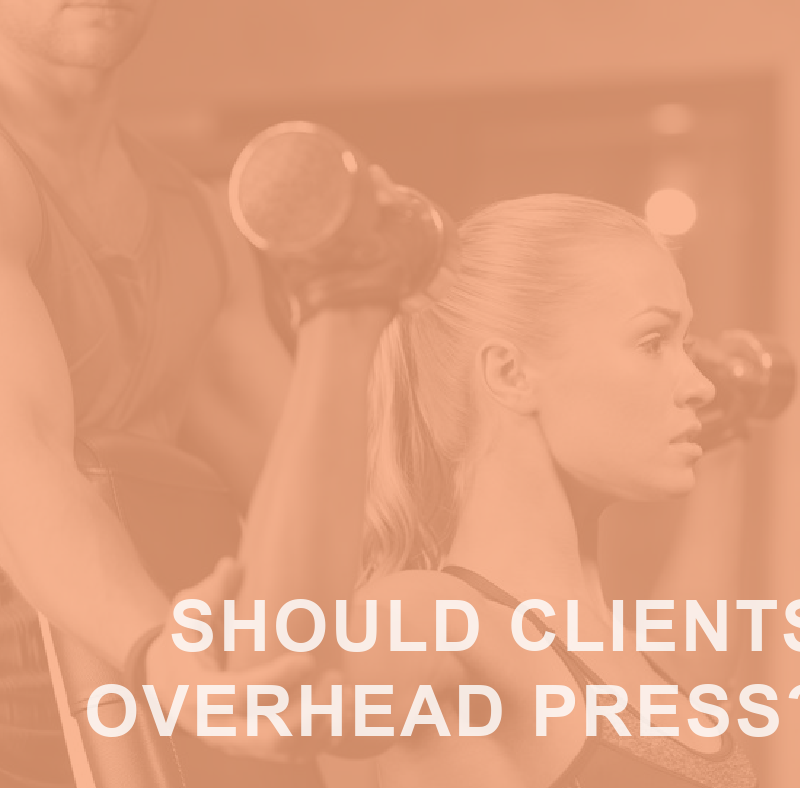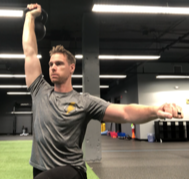
The overhead press has been a staple in resistance training since the very beginnings. Whether you are looking to build muscle and strength or overall work capacity in your shoulders, few could argue the benefits. Trainers should bear in mind, however, that overhead pressing may not be the best fit for each of your clients.
Assess, Don’t Guess, Before Overhead Press
One of the easiest ways to find out if a client is a good candidate for overhead pressing is to look at their shoulder mobility and core stability. Start by simply having a client stand and have them raise their arms overhead with arms straight without load.
Do they go into extension through their lower back? Or do they have to compensate by bending elbows or moving their head forwards?
Look at them both in front and from the side. If they exhibit any of the above signs from any angle, then they should NOT be overhead pressing. Yet.
Working Around Limitations
 Fortunately, there are a few things that your client can do:
Fortunately, there are a few things that your client can do:
1- Improve mobility: Assist and guide clients through self-myofascial release (foam rolling & soft tissue work) followed by stretching. Restrictions are usually found in the lats and in the internal rotators of the glenohumeral joint.
2- Increase body awareness: Some clients may need more help understanding what they are doing vs what they should be doing. Have them close their eyes while performing movements and put their attention on the muscles that are doing the work. Ask them what other sensations they notice outside of the working group.
3- Substitute in the Landmine Press: The landmine press is a great alternative to conventional overhead pressing as you are lifting in an arc motion which works all of the muscles in the shoulders as the overhead press without the mobility requirements.
Clients That Can Overhead Press
For clients that have the adequate requirements to overhead press, does it make sense to load them up on the bar first? I would say no. The Barbell Overhead Press is a great deltoid exercise but is less forgiving to the body when form isn’t impeccable. You are also forcing both hands in a fixed position such as the barbell which wouldn’t allow the freedom of movement that you can get from kettlebells and dumbbells. Lastly, think about who you are training, for the 40-year-old-plus clientele, the barbell may not be the best choice.
Biomechanics and function
The shoulder is made of a spiral-diagonal-rotational joint. It likes to move in rotation and doesn’t like to be forced into a fixed bar path like you would get with a straight bar. The shoulders also typically don’t like external rotation (most people do not have enough) so behind the head barbell presses can be dangerous to the rotator cuff. By using the three exercises below you will see that the shoulder responds best from recruiting the subscapularis to depress the humerus which is less likely to create shoulder impingement.
3 Exercises to Prepare Clients for Overhead Press:
Band Press https://www.youtube.com/watch?v=W1tkfqveXFc
Half Kneeling SA KB Bottoms up Press https://www.youtube.com/watch?v=lxMtPbhpLB4
Half Kneeling SA KB Overhead Press https://www.youtube.com/watch?v=ryBN-GicrUw
No “One Size Fits All”
One of the key aspects of personal training is just that–personal. We can not as professionals in our industry have all clients do the exact same exercises because everyone has individual needs based on how they move and function. The worst thing that could happen is an injury that could have been avoided by simply assessing first and then not cramming a square peg into a round hole. Give your clients what they need by keeping them safe and getting them great results from what they can do.






